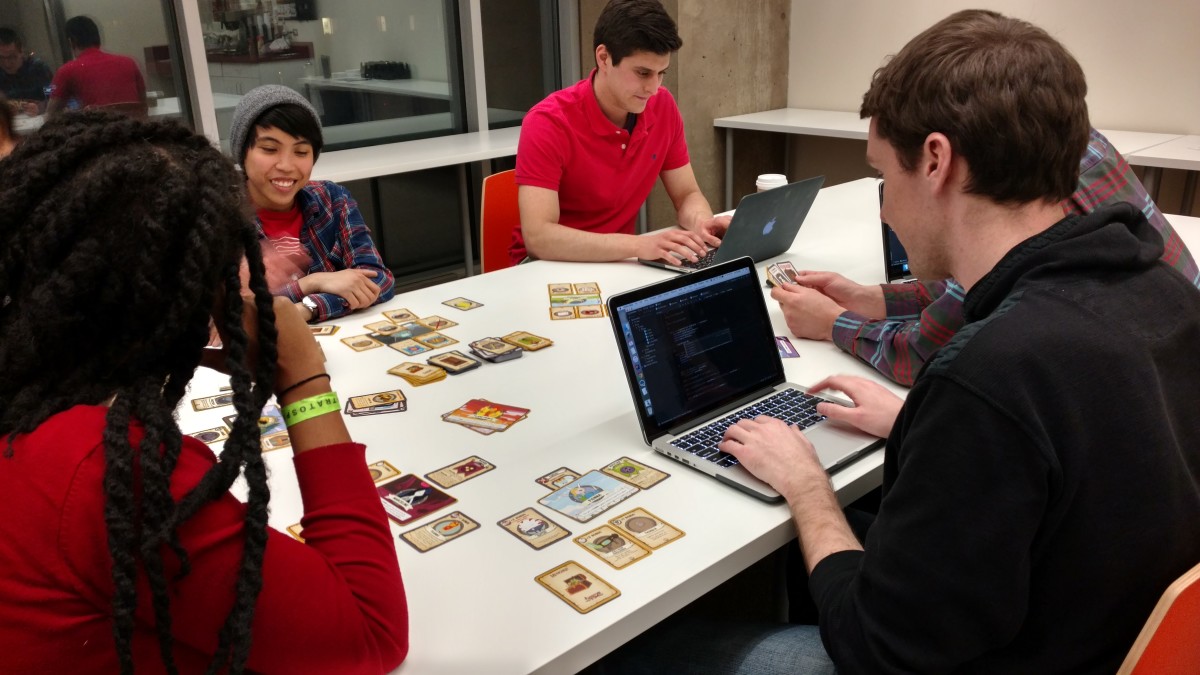Written by Technically Media CEO Chris Wink, Technical.ly’s Culture Builder newsletter features tips on growing powerful teams and dynamic workplaces. Below is the latest edition we published. Sign up to get the next one.
Freddie Gray died in police custody in spring 2015. The protest that followed in downtown Baltimore turned violent. And the Technical.ly newsroom had a spirited debate about whether, and how, we should contribute to a national conversation on violence against Black Americans.
It’s my earliest memory of the Technical.ly newsroom grappling with our role in a national racial justice movement. We felt ill-equipped as a local news organization focused on technologists and entrepreneurs, so we followed our community.
We pointed to a map that a pair of local software developers were using to track where civil unrest was happening. We re-shared a chillingly prophetic data analysis made by a software CEO months earlier to demonstrate how similar Baltimore was to Ferguson, Missouri, where protesters and police battled the year prior after the shooting of Michael Brown. We followed open data insights and later the revelations that Baltimore police used a social media listening service to track protestors.
As camera phone quality progressed and social media went mainstream, our awareness of police killings of unarmed Black people became painfully routine. Racial justice was a technology story.
The glaring lack of representation of Black and brown people in software and entrepreneurship was always a focus for Technical.ly’s coverage, dating back to our founding in 2009. Much of that reporting led to co-hosting the “What It Takes to Be Black Tech Entrepreneur” summit in 2012. Just months earlier, Trayvon Martin was killed by George Zimmerman in Florida.
We saw a direct connection between a lack of representation in high-earning tech careers to disproportionate poverty and violence. But if I’m being honest, as Technical.ly’s white male founder, I hadn’t yet entirely connected our reporting to how our company could operate. That’s changed, and we may prove a helpful case study for others interested in combating racial inequality.
###
“White exceptionalism” describes self-assured white people who are confident in their righteousness. As that thinking goes, since you’ve read the right books and think the right thoughts, you must be one of the good guys. But it’s just a trap.
“If you believe you are exceptional, you will not do the work,” wrote Layla Saad in her 2020 book,“Me & White Supremacy.”
Better to recognize that centuries of systematic oppression of Black and brown people have resulted in a twisted snarl of societal diseases and bring humility to any effort to reverse its course. As Maya Angelou famously wrote: “Do the best you can until you know better. Then when you know better, do better.”
Two years since George Floyd’s murder shocked into existence the next chapter of the racial justice movement, the Technical.ly newsroom again used this month to more closely examine racial equity in tech. The stakes are high: Both a moral imperative and economic demands necessitate better representation among those with technical skills and entrepreneurial zeal.
Since we as a news organization so routinely look at the diversity, equity and inclusion practices of others, editor Sameer Rao asked me: Shouldn’t we look at ourselves too? Otherwise, we risk falling into a sense of white exceptionalism, loathsomely assuming our journalistic do-goodery absolves us of this crucial work. If Technical.ly gathers insights for our community of technologists and entrepreneurs, and even guides our clients on the matter, how are we doing?
What has Technical.ly done to contribute to more inclusive economies, and a more representative company?
Our earliest editorial meetings included debates on how to prod more visibility for technologists and entrepreneurs of color without drifting into tokenism. If a group of people you report on is disproportionately white, there is a fine line between lifting up underrepresented voices and outright obfuscation of the truth.
We picked our battles; I remember a lot of “calling in” of event organizers by privately encouraging them to ensure their speaker lists were more representative — later, we started calling them out. We asked entrepreneurs about their lack of staff diversity. We wrote often of the economic and moral opportunities lost, and gathered the data that told that story.
Internally, though, we hit obstacles. In 2017, I led a disaster of an all-staff meeting aimed at establishing a staff social media policy, resulting in more than one staff member crying. How politically active could our individual reporters be on their personal social media accounts? We never established anything meaningful, and I retreated from the whole process.
We routinely questioned what our goals and responsibilities were — we still do. We debated what storytelling would be most effective, and I often felt like we were behind the vanguard in company policies. For one, I over-complicated how we honored Dr. Martin Luther King Jr. Day, and I waited too long to declare Juneteenth a company holiday, despite a former employee encouraging me to do so years earlier.
Members of our team, including myself, completed several inclusive leadership and diversity, equity and inclusion trainings. By the time of the June 2020 social eruption, we at Technical.ly felt far more prepared for the moment than we were in 2015.
We made our own company pledge, enlisted experts and challenged our community: Given the scale of the movement, silence would be remembered as violence. Even still, we hit roadblocks — we enthusiastically helped organize a cleanup after protests turned destructive in Center City, which was criticized for focusing on a wealthier downtown district, rather than long disinvested neighborhoods.
We all demanded more from each other. Fifty years of prioritizing shareholder value above all else was being challenged: Tech CEOs had nowhere to hide. That had to mean me too, as Technical.ly’s top leader.
So what have we done internally since?
- Compensation analysis: We analyzed take-home pay by race, gender, age. In overall compensation, there was little variation, but our operations manager found our white employees contributed to their 401k on average double what our employees of color did. To close the gap, the company made an immediate across-the-board contribution to all employees. Later we additionally increased the overall percentage match, while making a financial adviser available for all employees. We closed but not erased the difference.
- Mental health resources: We outlined for staff the available free and low-cost mental health and therapy options, both for those in and out of our health insurance plan. (The company also increased our health insurance contribution.)
- Supporting Black-owned businesses: We offered in-kind support to promoting Black-owned tech businesses, which we added to our client roster.
- Job description audit: We reviewed our job description template, adding new language encouraging candidates to apply whether or not they feel they have all the listed skills and requirements.
- Clearly defined chain of command: Our staff manual lists an array of people who can be contacted to lodge complaints or discuss internal issues, including those with specialized training and people with various backgrounds.
- Anonymous annual staff survey: We updated our long-standing survey that gives staff the most secure way to give feedback.
- Staff and leadership metrics: We continue to monitor our staff diversity at various levels.
- Updated exit interview process: We now let exiting employees choose who will lead their outgoing exit interviews, allowing for maximum disclosure.
- Progress audit: Within a month of our stated commitments to progress, I personally reviewed what we had done so far, and what more we needed to do.
Many of these were continuations of existing efforts. They all started as modest first steps. In fall 2019, Technical.ly was honored as a “diversity champion.” That may sound very nice, but that kind of honor is worth very little if the scrutiny is not maintained.
Rather than stressful, it can be freeing. If every day is a new chance to get it wrong then each day is also a new chance to get right. Pushing off activism because you feel unready is what author Saad calls “perfectionism.” It’s another way to avoid doing the work.
That means though we’ve taken steps in the past, we are primarily rewarded with new steps for the future. There’s no limit to what comes next. What feels most immediate for us?
- More transparent salary bands: Though we have rough salary levels used internally, these have changed quite a bit in the last couple years and this has not been shared with our whole team. Salary transparency is commonly thought to disproportionately help guide employees of color and others with less experience and network in similar settings.
- More staff training: We’re hosting a series of workshops on diversifying a workforce for our community, and several of the sessions would be helpful for anyone on our team who is interested. We can do better to encourage more of our team to participate in the learning we offer.
- More thorough source audit: Though our newsroom has long prioritized source diversity, we have not instituted a plan for source demographic tracking — we have done this for individual series but not across all our editorial.
This is small and incomplete. It won’t stop us from working to improve.
Most substantially, it’s important to set definable goals. We say internally that our team and our coverage should reflect the communities we serve, but that’s imprecise. We can do far better to set clearer targets.
At the highest level, it’s my personal belief that it is abhorrent that race can be so effective a predictor of economic outcomes. That’s the highest order correlation I believe we should be part of dismantling. When we progress on these, there will be more. As a friend of mine likes to remind me: Equity is a direction, not a destination.
###
To write this, I looked back at what bridged us from our distant, if thoughtful, reporting on social justice in 2015 to the spark of 2020 — including our own reporters joining the protests. Racial equality has been a goal for centuries, and the Civil Rights Movement is decades old; the Black Lives Matter movement first gained traction online in 2013.
Each step has stood on the progress of what came before it. That’s also true for our work at Technical.ly.
A pivotal moment again came from my own community. In summer 2016, another spate of police killings sparked a painful conversation among my coworkers, especially within a group chat among our employees of color. Though our reporting had long stood for something, how should our company handle internally this triggering news?
At first I felt sensitive. Our newsroom addressed important issues and horrible things that happen every day; how could a news organization respond to each one? Looking back, I was feeling what author Brene Brown calls “the warm wash of shame.” Our newsroom wanted to cover our own efforts. Sensitive as it might be, it felt like the right thing for our community. The result, which detailed our internal approach, remains one of the most influential moments in my career.
As the activist-librarian Audre Lorde said in 1982: “Revolution is not a one-time event.”
Sign up for the Culture Builder newsletter
This editorial article is a part of Racial Equity in Tech Month 2022 of Technical.ly's editorial calendar. This month’s theme is underwritten by Spotify. This story was independently reported and not reviewed by Spotify before publication.
Before you go...
Please consider supporting Technical.ly to keep our independent journalism strong. Unlike most business-focused media outlets, we don’t have a paywall. Instead, we count on your personal and organizational support.
3 ways to support our work:- Contribute to the Journalism Fund. Charitable giving ensures our information remains free and accessible for residents to discover workforce programs and entrepreneurship pathways. This includes philanthropic grants and individual tax-deductible donations from readers like you.
- Use our Preferred Partners. Our directory of vetted providers offers high-quality recommendations for services our readers need, and each referral supports our journalism.
- Use our services. If you need entrepreneurs and tech leaders to buy your services, are seeking technologists to hire or want more professionals to know about your ecosystem, Technical.ly has the biggest and most engaged audience in the mid-Atlantic. We help companies tell their stories and answer big questions to meet and serve our community.
Join our growing Slack community
Join 5,000 tech professionals and entrepreneurs in our community Slack today!






